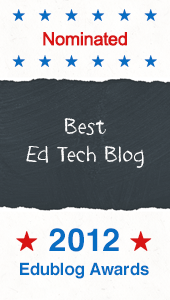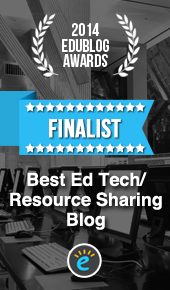Home » Archives for 8/1/14 - 9/1/14
ThingLink EDU September Webinar Series
- on 7:07 AM
- No comments
A ThingLink PD Toolkit of Resources
in
creative commons,
elearning,
pd,
resources,
SAMR,
slideshow,
tech coach,
thinglink,
ThingLink Teacher Challenge,
webinar
- on 12:07 PM
- No comments
This summer I spent much of my work time helping educators learn to embrace the power of ThingLink as a tool for Teaching and Learning. Along the way, I created a wealth of resources using a variety of formats to accommodate the learning needs of busy teachers.
The resources created have been collected and curated into one interactive image. I believe they are valuable for personal learning needs, as well as for use during professional development offerings. They were created to be shared and reused.
The resources created have been collected and curated into one interactive image. I believe they are valuable for personal learning needs, as well as for use during professional development offerings. They were created to be shared and reused.
Labels:
creative commons,
elearning,
pd,
resources,
SAMR,
slideshow,
tech coach,
thinglink,
ThingLink Teacher Challenge,
webinar
ThingLink Educators Featured on Huffington Post
- on 8:43 AM
- 1 comment
Readers of the Huffington Post today will discover a wonderful article featuring ThingLink and three amazing educators, Jamie Forshey, Lisa Johnson, and Sue Fitzgerald. The article by CM Rubin, The Global Search for Education: Pictures with Links highlights examples of innovative ways to use ThingLink for teaching and learning along with explanations provide by these three creative educators.
Check out The Global Search for Education: Pictures with Links on the Huffington Post.
Check out The Global Search for Education: Pictures with Links on the Huffington Post.
Padlet Mini - Quickly Collect & Curate Content
- on 10:32 AM
- No comments
Padlet Mini is a handy new toolbar extension for Chrome and Safari that's designed to help users collect and curate web content in a couple of clicks. Bookmarking with Padlet mini couldn't be easier or more efficient.
With the extension installed, users who discover web content worth collecting can click on the Padlet icon in the toolbar and select an existing Padlet to post content to. Click once more and the content is displayed on your Padlet wall.
The Padlet Mini extension works similarly to other toolbar bookmarking tools, but the possibilities for using Padlet in the classroom have put Padlet Mini at the top of my list of quick click bookmarking tools.
With the extension installed, users who discover web content worth collecting can click on the Padlet icon in the toolbar and select an existing Padlet to post content to. Click once more and the content is displayed on your Padlet wall.
The Padlet Mini extension works similarly to other toolbar bookmarking tools, but the possibilities for using Padlet in the classroom have put Padlet Mini at the top of my list of quick click bookmarking tools.
Free Webinar: Transform Teaching & Learning with ThingLink
in
#edchat,
#EdReform,
#elearning,
#multimedia,
#udl,
Professional development,
thinglink,
webinar
- on 10:47 AM
- No comments
Are you looking for a user friendly and flexible tool to help you easily create engaging multimedia rich content to redefine teaching and learning? Are you interested in using technology to meet the personal learning needs of the students in your classroom? We invite you to attend our free webinar and explore the powerful possibilities that exist with ThingLink EDU.
Labels:
#edchat,
#EdReform,
#elearning,
#multimedia,
#udl,
Professional development,
thinglink,
webinar
Blogging to Learn
in
blog,
pd,
PLN
- on 10:25 AM
- No comments
As the start of the school year approaches, educators are busy preparing for a great year. As learners, many of us will approach the new year with excitement and optimism after reflecting on our own teaching during our time away from the classroom.
Those of us who sport a growth mindset typically start each school year with the intention of being better. We have collected new ideas, thoughtfully considered how to implement them, and we are excited to make a difference in the lives and education of our students.
I truly believe that all educators should consider blogging as a tool for learning and this seems like the perfect opportunity to once again try to encourage all educators to blog!
Why I Blog
Blogging about experiences makes me accountable for taking the time to thoughtfully reflect on teaching and pursue ways to kick the learning up a notch. I learn more from blogging than from any other professional activity I participate in. Quite simply, I blog to learn.Why Educators Should Blog
Becoming a blogger is perhaps one of the most powerful ways to grow as an educator. For many, blogging can become an essential part of the workflow, requiring us to dig deeper, engage in research, explain and reflect. Good blogging should include exploring the blogs of others as models, and sharing ideas and resources with your audience. The audience may be students, teaching teams, parents, or educators across the world. Blogging will ultimately help you become a connected educator.
Why Students Should Blog
Blogging provides students with authentic opportunities to improve writing, engage in research, read more and personally connect with their own learning through thoughtful reflection. If that's not enough, please consider these ideas.
- Blogs offer an exciting way for students to engage in real-world writing.
- Blogs give students a voice and an audience.
- Students write better and put more thought into the revision process when they are publishing for an audience.
- Blogs allow for feedback through comments which can be very motivating.
- Blogging requires students to engage in everyday research and dig deeper to construct knowledge through the synthesis of ideas.
- Blogging provides students with opportunities to connect with their own learning by remixing content, developing new ideas, and thoughtfully reflecting.
- Blogging provides educators with many opportunities for teaching students about digital citizenship, including Internet safety, crediting sources and practicing good online etiquette.
- Student blogs provide parents with a convenient and personalized opportunity to connect with their children's learning experiences.
Advice About Blogging
Throughout the course of my career as a blogger, I have helped many teachers get up and running with a blog. Here is my advice, based on The School of Hard Knocks, so to speak.
- Start simple! A new blog will have just one post. Write the post for yourself to explain why you have decided to start a blog.
- Since it takes time and effort to get people to check a blog, do not spend hours and hours filling your blog with information. Just use the blog as a tool for yourself, but write it for an audience.
- As you continue to experiment with blogging, explore the use of simple original images to capture visitors' attention.
- Learn to embed.
- Model good digital citizenship. We expect students to use copyright-friendly images, credit sources and share their own original work, and it's important for education bloggers to dig deep into Best Practices and try it yourself.
- When you are ready to share your blog with the world, use Twitter and other social media platforms to connect with educators and build your PLN.
- Share your blog with your students and provide them with opportunities to blog.
Free Online Event: Improve Writing with Google Docs
in
#GAFE,
#SK12,
google docs,
webinar
- on 9:25 AM
- No comments
Would you like to improve your students' writing skills and help them bridge the gap between writing in school and writing in the real world?
One way of doing so is by using digital writing and Google Docs, the documents editor available in Google Drive. Since Google Docs is collaborative and available 24/7, students using Google Docs often write more frequently and better than when given traditional paper and pencil writing tasks.
One way of doing so is by using digital writing and Google Docs, the documents editor available in Google Drive. Since Google Docs is collaborative and available 24/7, students using Google Docs often write more frequently and better than when given traditional paper and pencil writing tasks.
EdTech You Should Know
in
#ISTE2014,
EdTechToKnow,
podcast,
thinglink
- on 10:06 AM
- No comments
 EdTech You Should Know is a new show in the Instructional Tech Talk network of podcasts, created and facilitated by innovative educator Jeff Herb. The show features one educational technology tool per episode that is worth knowing about. The episodes are less than 10 minutes and they are designed to offer educators a taste of the great EdTech that's out there.
EdTech You Should Know is a new show in the Instructional Tech Talk network of podcasts, created and facilitated by innovative educator Jeff Herb. The show features one educational technology tool per episode that is worth knowing about. The episodes are less than 10 minutes and they are designed to offer educators a taste of the great EdTech that's out there. Engage Students in Informed Decision Making
in
#inspired,
#ThingLink_EDU,
#TLChallenge,
edreform,
homework,
multimedia,
Polldaddy
- on 9:35 AM
- No comments
With access to an abundance of online resources, students can become informed decision makers and stakeholders in their own learning. Use of online polls, surveys, and digital tools for collecting feedback can turn passive observers into active participants.
The ThingLink Teacher Challenge this week asked educators to explore the use of an interactive image for informing and collecting feedback from an audience. We introduced Polldaddy as an integrated tool for the task. Polldaddy is an excellent choice because rich-media tags support embedding of a poll into an interactive image, allowing the poll to pop up without leaving the page. Of course, there are many web tools available for collecting feedback and any of those tools can be linked to a ThingLink interactive image.
Connect & Collaborate Through Global Virtual Classroom
in
global learning,
Global Virtual Classroom,
Janet Barnstable
- on 7:00 AM
- No comments
For many years my dear friend and mentor, Janet Barnstable, has been part of an amazing Global collaborative project, The Global Virtual Classroom (GVC). As we approach the start of the school year and registration opens for this year’s participants, I asked Janet to write a guest post to share this great learning opportunity with readers of this blog. I hope you will consider connecting and collaborating internationally through GVC.





















